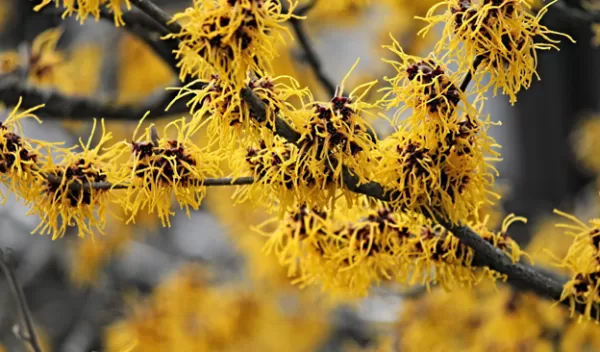
Blink and you'll miss these plants shooting their seeds
If you happened upon a witch hazel plant in the forest, you might describe it as a sweet-smelling shrub with crinkly ribbon-like petals. But to Duke University researcher Justin Jorge, it's a howitzer. That's because of the impressive firepower of its fruits.
When witch hazels are ready to disperse their seeds, their woody seed capsules split open. Pressure builds up, and eventually the seeds shoot out like bullets fired from a rifle, hitting 30 feet per second in about half a millisecond.
"If you blink, you'll miss it," said Jorge, who worked on this project with senior author Sheila Patek. The seed-shooting happens way too fast to see with a regular camera, so Patek's team used a high-speed video camera capable of recording at 100,000 frames per second.
The U.S. National Science Foundation-supported researchers collected fruits from three members of the witch hazel family found in Duke Gardens and Duke Forest.
"It's the precise shape change of the tissues in a very restricted space that creates the launch," said Miriam Ashley-Ross, a program director in NSF's Division of Integrative Organismal Systems. "This mechanism could inspire hard-to-detect launch mechanisms in tight spaces."
Some of the smallest seeds weighed in at 15 milligrams — lighter than a grain of rice — while others were 10 times more massive. And yet the witch hazels were able to fling heavy seeds just as fast as lighter ones.
"We found that the launch speeds were all roughly the same," Jorge said. "Given the order of magnitude difference in seed masses, I was not expecting that at all."
In a study published in Journal of the Royal Society Interface, the researchers looked into how the plants do it. It turns out the secret lies in the spring-loaded launch. The three species in the study use the same mechanism to shoot their seeds.
Before the seeds pop out, the fruit capsule around them dries out and deforms, like a piece of wood when if warps. It's the walls of the woody fruit capsule squeezing in that eventually send the seed flying. "It's similar to how you can shoot out a watermelon seed by squeezing it between your fingers," Jorge said.
To launch a cannonball the same speed as a bullet, you'd need to put more force behind it. Witch hazel fruit capsules work the same way. For each species, the researchers estimated the elastic potential energy stored in the spring-like seed capsule by measuring how much force it took to wedge its seed back into place.
They found that witch hazel species with heavier seeds also have larger capsules that can store more elastic energy. The researchers say new insights from studying nature could lead to better designs for robots.
